Jaisalmer
The fort of Jaisalmer is awe-inspiring, with a giant sandcastle rising from the sandy plains like a mirage from another time. Jaisalmer is the perfect site to watch exotic camel-train trading routes and desert mysteries. Nineteen-nine bastions encircle the fort’s still-inhabited tortuous corridors. Inside, you’ll see brightly embroidered shops, a regal palace, and a plethora of enterprises vying for your money.
Despite its prominent commercialism, this desert citadel is a fascinating sight. The small lanes of the old city, particularly to the north, conceal beautiful Havelis all carved from the same golden-honey sandstone as the fort – hence Jaisalmer's nickname as the Golden City. Jaisalmer, a city that has nearly recovered from the brink of extinction in the last half-century, may be remote, but it is far from forgotten, and it is one of Rajasthan's most beautiful tourist attractions.
Jaisalmer Fort has an impressive history and watcher of several battles with the Mughals, Tughalaqs, Khiljis, and Rathore Kings. Raja Rawal Jaisal built the fort in 1156 AD. However, a fortified defence structure called Rang Rawal Jethsi was added Burj to it in 1276 AD after two invasions by the Sultan of Delhi Alauddin Khilji. However, a fortified defence structure called Rang Rawal Jethsi was added Burj to in 1276 AD after two intrusions by the Sultan of Delhi Alauddin Khilji. For around 8–9 years, Sultan Alauddin Khilji’s forces besieged the fort. In 1294, the Sultan finally conquered Jaisalmer Fort from the Bhati Rajputs after many attempts. Jauhar, or self-immolation, was forced on around 25,000 women for the sake of their honour.
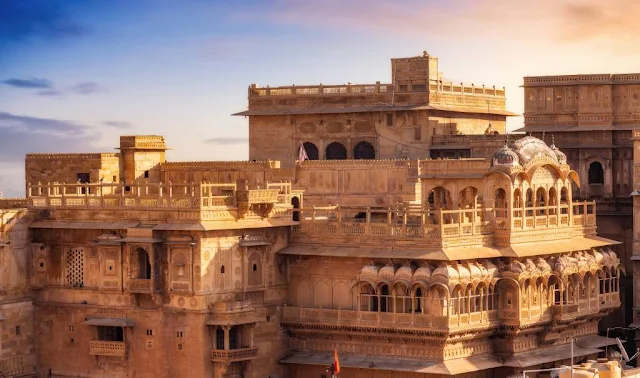 |
| Jaisalmer Fort: Wonderful Architecture |
The only living fort in India still has many descendants of Rajput and Brahmin families. The castle is a popular tourist attraction in Jaisalmer, even though it is no longer a vital military stronghold or commercial centre. In 2013, UNESCO declared it a World Heritage Site. The fort is open to visitors on a self-guided tour or by hiring a guide. Near the ticket counter, audio tours are also available. You can also visit the Fort Palace Museum, the Jain Temples, the Havelis, and other attractions in addition to enjoying the fort's architecture.
Jaisalmer Fort: Wonderful Architecture
The Jaisalmer Fort is a combination of the Mughal and Rajput buildings. It is an architectural masterpiece that combines Mughal and Rajput traditions. This 1500-foot long and 750-foot broad fort has many palaces, houses, temples, wells, Havelis, and other structures inside and around it, all made of yellow sandstone. The Jaisalmer Fort is a sight to behold during the day; during the daytime, it dazzles in the sunlight in a sparkling golden colour and takes on a honey-gold shade at sundown. The focal points of the fort are:
- Ganesh Pol, Suraj Pol, Bhoot Pol, and Hawa Pol are four massive and exquisitely sculpted entrance gates that form an exquisite sculpture ensemble.
- Intricate carvings and eye-catching designs on the windows, doors, balconies, and arches
- Jaisalmer Fort has beautiful carved Havelis and Jain and Hindu temples. They decorate the Jain temples and exhibit the popular Dilwara temple style with multiple mirrors, carvings, and paintings.
- The marvel of architecture and craftsmanship of an enormous courtyard called Dussehra Chowk
- The exquisite stone carvings, murals, and jalis of Patwon Ki Haveli, which is just outside the old fortification, are particularly magnificent.
Jaisalmer Fort’s location on Trikuta Hill, which is 250 feet above the surrounding town, adds to its majestic beauty and makes it a must-visit tourist attraction. And when you are up there, you can also take in the breathtaking views of the town from Dussehra Chowk and other parts of the fort.
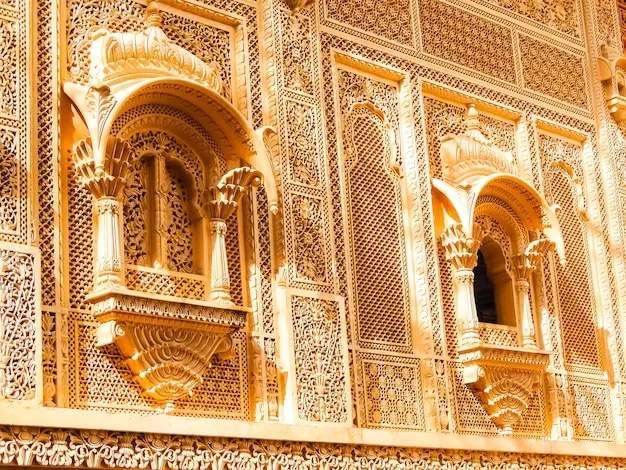 |
| Jaisalmer Fort: Wonderful Architecture |
Jaisalmer Fort has lesser-known facts.
- They used stone for the outermost layer. For better defence against adversaries, they built the fort with three tiers of walls.
- They constructed the Jaisalmer castle between 1633 and 1647, and it comprises 99 bastions.
- The wells of Jaisalmer Fort continue to supply water regularly.
- The king attends a large fair here during Dussehra.
JAISALMER GOVERNMENT MUSEUM
It is a popular tourist destination in Jaisalmer, and they run by the Department of Archaeology and Museums. The award of Godawan, the bird of the state of Rajasthan, is the most spectacular presentation. Traditional household goods, rock-cut pottery, jewellery, and statues from the 7th and 9th centuries AD are among the city's rich cultural history on display.
PATWON KI HAVELI
This five-story structure is one of Jaisalmer's largest and most intricately carved Havelis and stands proudly on a roadway. While the haveli has lost part of its former splendour, there are still a few paintings and mirrorwork art on the inside walls.
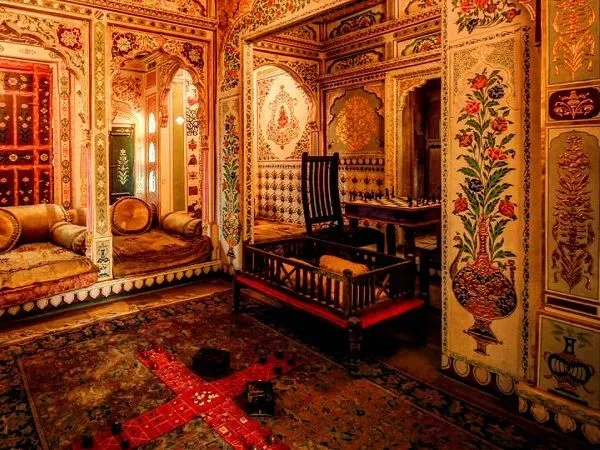 |
| PATWON KI HAVELI |
SALIM SINGH KI HAVELI
Many progenies of original residents still live in a part of the haveli, which dates back to the first half of the 18th century. The carved brackets in the shape of peacocks support the high-arched roof. According to legend, two wooden stories would have brought it up to the same height as the Maharaja's palace.
MANDIR PALACE
Tazia Tower, with its pagoda-like appearance, complements the five-story splendour of the Badal Mahal. Tourists can see a beautifully carved balcony on each story of the palace. The Badal Palace owes its beauty to Muslim artisans who sculpted the tower in the style of a Tazia (a float used in the Muharram procession).
JAIN TEMPLES OF JAISALMER
The Jain community built the Jain Temples within the Jaisalmer Fort between the 12th and 15th centuries. Rikhabdevji, and Shambhavdevji, two great Jain hermits known as ‘Tirthankars,’ are honoured in the temples (wise teachers who teach people how to attain enlightenment). The Jain community sculpts the temples out of yellow sandstone, just like the rest of Jaisalmer’s architecture. They constructed them in the well-known Dilwara style for their stunning architecture.
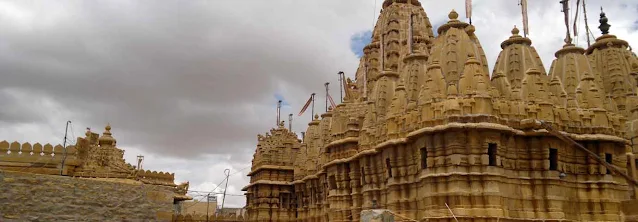 |
| JAIN TEMPLES OF JAISALMER |
DESERT NATIONAL PARK
The Desert National Park showcases the Thar Desert's diverse environment and animals. Undulating dunes, jagged boulders, deep salt lake bottoms, and inter-medial regions make up the park. The park is home to many creatures, including black deer, chinkara, and desert fox. Here you may observe the critically endangered Great Indian Bustard, one of the world's massive flying birds. The park attracts a wide range of migrating raptors in the winter, including Himalayan and Eurasian Griffon Vultures, the Eastern Imperial Eagle, and the Saker Falcon.
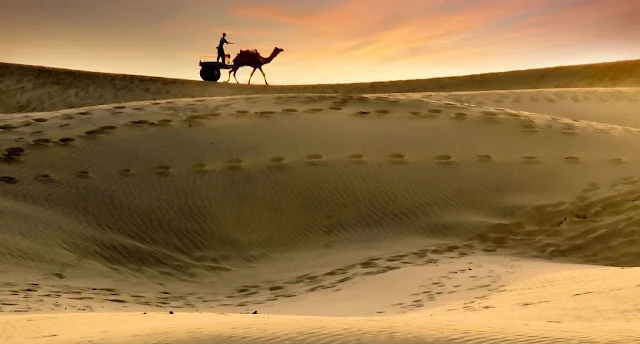 |
| DESERT NATIONAL PARK |
- Welcome Heritage Mohangarh Fort and Jaisalmer Marriott Resort are the best star-rated hotels available in Jaisalmer.
- Direct rail service between Jaisalmer and Delhi is available, and a few trains link the two cities.
- Jaisalmer is accessible by bus and cab to Jodhpur, Bikaner, and Jaipur. Jaisalmer has a civil airport and direct flight access from Jaipur, Delhi, Mumbai, Bangalore, and Surat.